Coca-Cola Brand Management: Strategies, Equity, and Portfolio Analysis
VerifiedAdded on 2021/02/18
|16
|5065
|1023
Report
AI Summary
This report provides a comprehensive analysis of Coca-Cola's brand management strategies. It begins with an introduction to brand management and its importance, focusing on Coca-Cola as a case study. The report explores the importance of branding as a marketing tool, examining how Coca-Cola builds brand recognition, attracts customers, and generates revenue. It then delves into the key components of a successful brand strategy, including building brand awareness, communicating brand significance, and fostering consumer bonds. The report further examines different strategies of portfolio management, brand hierarchy, and brand equity management, explaining the various approaches and their application to Coca-Cola. Additionally, it discusses how brands are managed collaboratively and in partnership, both globally and domestically. Finally, the report analyzes techniques for measuring and managing brand value in relation to developing a strong and enduring brand, offering insights into Coca-Cola's approach to enhancing its brand value. The report aims to provide a thorough understanding of Coca-Cola's brand management practices and their impact on the company's success.

Brand Management
Paraphrase This Document
Need a fresh take? Get an instant paraphrase of this document with our AI Paraphraser
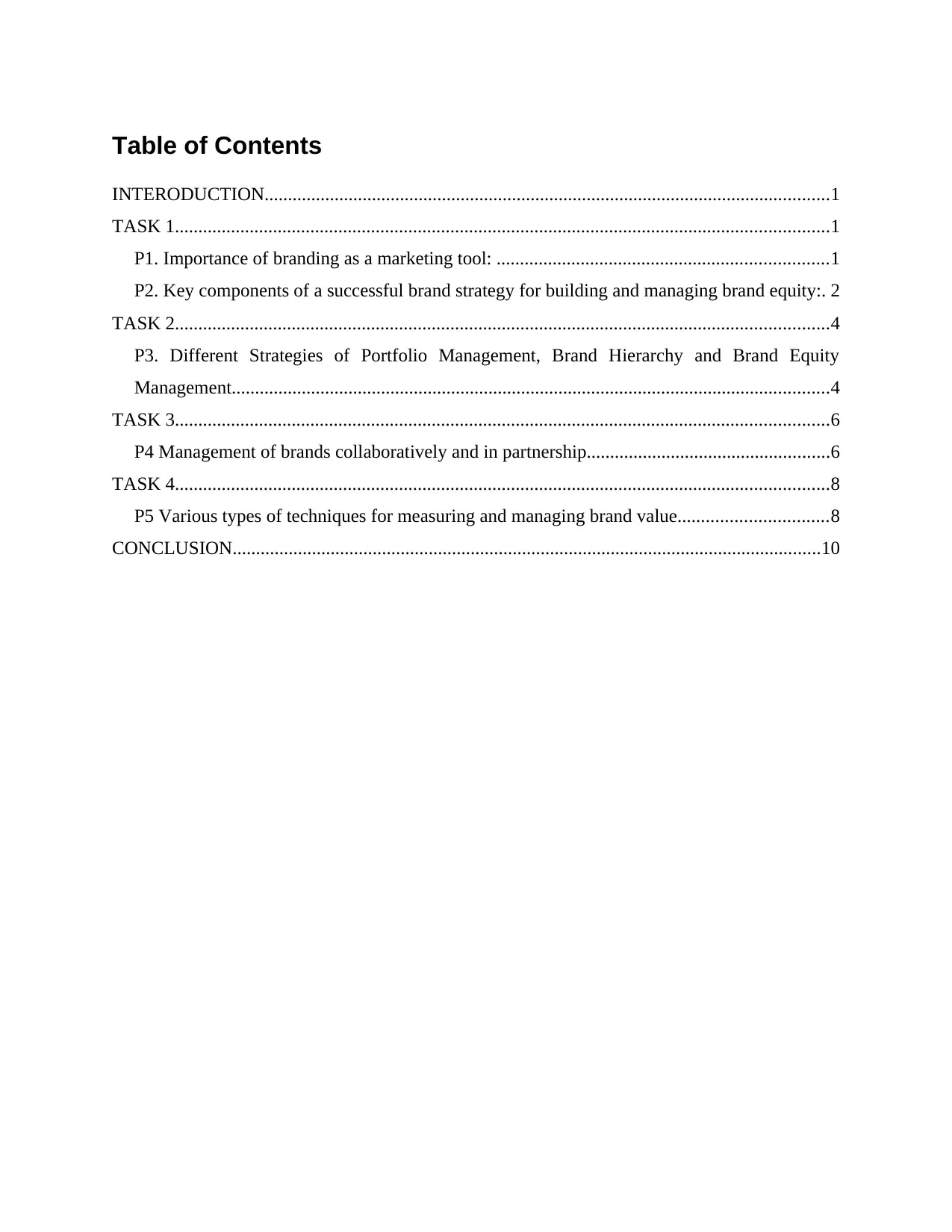
Table of Contents
INTERODUCTION.........................................................................................................................1
TASK 1............................................................................................................................................1
P1. Importance of branding as a marketing tool: .......................................................................1
P2. Key components of a successful brand strategy for building and managing brand equity:. 2
TASK 2............................................................................................................................................4
P3. Different Strategies of Portfolio Management, Brand Hierarchy and Brand Equity
Management................................................................................................................................4
TASK 3............................................................................................................................................6
P4 Management of brands collaboratively and in partnership....................................................6
TASK 4............................................................................................................................................8
P5 Various types of techniques for measuring and managing brand value................................8
CONCLUSION..............................................................................................................................10
INTERODUCTION.........................................................................................................................1
TASK 1............................................................................................................................................1
P1. Importance of branding as a marketing tool: .......................................................................1
P2. Key components of a successful brand strategy for building and managing brand equity:. 2
TASK 2............................................................................................................................................4
P3. Different Strategies of Portfolio Management, Brand Hierarchy and Brand Equity
Management................................................................................................................................4
TASK 3............................................................................................................................................6
P4 Management of brands collaboratively and in partnership....................................................6
TASK 4............................................................................................................................................8
P5 Various types of techniques for measuring and managing brand value................................8
CONCLUSION..............................................................................................................................10
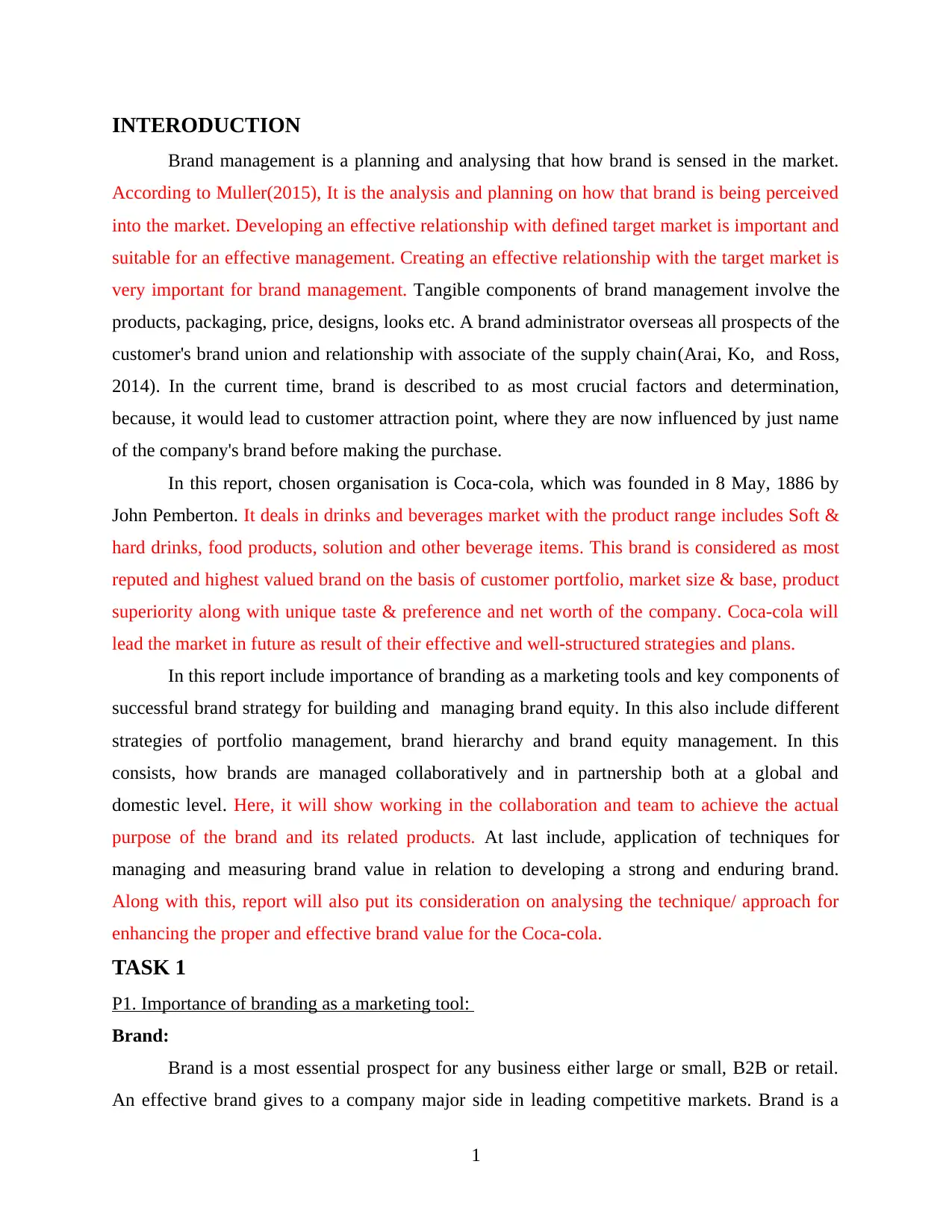
INTERODUCTION
Brand management is a planning and analysing that how brand is sensed in the market.
According to Muller(2015), It is the analysis and planning on how that brand is being perceived
into the market. Developing an effective relationship with defined target market is important and
suitable for an effective management. Creating an effective relationship with the target market is
very important for brand management. Tangible components of brand management involve the
products, packaging, price, designs, looks etc. A brand administrator overseas all prospects of the
customer's brand union and relationship with associate of the supply chain(Arai, Ko, and Ross,
2014). In the current time, brand is described to as most crucial factors and determination,
because, it would lead to customer attraction point, where they are now influenced by just name
of the company's brand before making the purchase.
In this report, chosen organisation is Coca-cola, which was founded in 8 May, 1886 by
John Pemberton. It deals in drinks and beverages market with the product range includes Soft &
hard drinks, food products, solution and other beverage items. This brand is considered as most
reputed and highest valued brand on the basis of customer portfolio, market size & base, product
superiority along with unique taste & preference and net worth of the company. Coca-cola will
lead the market in future as result of their effective and well-structured strategies and plans.
In this report include importance of branding as a marketing tools and key components of
successful brand strategy for building and managing brand equity. In this also include different
strategies of portfolio management, brand hierarchy and brand equity management. In this
consists, how brands are managed collaboratively and in partnership both at a global and
domestic level. Here, it will show working in the collaboration and team to achieve the actual
purpose of the brand and its related products. At last include, application of techniques for
managing and measuring brand value in relation to developing a strong and enduring brand.
Along with this, report will also put its consideration on analysing the technique/ approach for
enhancing the proper and effective brand value for the Coca-cola.
TASK 1
P1. Importance of branding as a marketing tool:
Brand:
Brand is a most essential prospect for any business either large or small, B2B or retail.
An effective brand gives to a company major side in leading competitive markets. Brand is a
1
Brand management is a planning and analysing that how brand is sensed in the market.
According to Muller(2015), It is the analysis and planning on how that brand is being perceived
into the market. Developing an effective relationship with defined target market is important and
suitable for an effective management. Creating an effective relationship with the target market is
very important for brand management. Tangible components of brand management involve the
products, packaging, price, designs, looks etc. A brand administrator overseas all prospects of the
customer's brand union and relationship with associate of the supply chain(Arai, Ko, and Ross,
2014). In the current time, brand is described to as most crucial factors and determination,
because, it would lead to customer attraction point, where they are now influenced by just name
of the company's brand before making the purchase.
In this report, chosen organisation is Coca-cola, which was founded in 8 May, 1886 by
John Pemberton. It deals in drinks and beverages market with the product range includes Soft &
hard drinks, food products, solution and other beverage items. This brand is considered as most
reputed and highest valued brand on the basis of customer portfolio, market size & base, product
superiority along with unique taste & preference and net worth of the company. Coca-cola will
lead the market in future as result of their effective and well-structured strategies and plans.
In this report include importance of branding as a marketing tools and key components of
successful brand strategy for building and managing brand equity. In this also include different
strategies of portfolio management, brand hierarchy and brand equity management. In this
consists, how brands are managed collaboratively and in partnership both at a global and
domestic level. Here, it will show working in the collaboration and team to achieve the actual
purpose of the brand and its related products. At last include, application of techniques for
managing and measuring brand value in relation to developing a strong and enduring brand.
Along with this, report will also put its consideration on analysing the technique/ approach for
enhancing the proper and effective brand value for the Coca-cola.
TASK 1
P1. Importance of branding as a marketing tool:
Brand:
Brand is a most essential prospect for any business either large or small, B2B or retail.
An effective brand gives to a company major side in leading competitive markets. Brand is a
1
⊘ This is a preview!⊘
Do you want full access?
Subscribe today to unlock all pages.

Trusted by 1+ million students worldwide
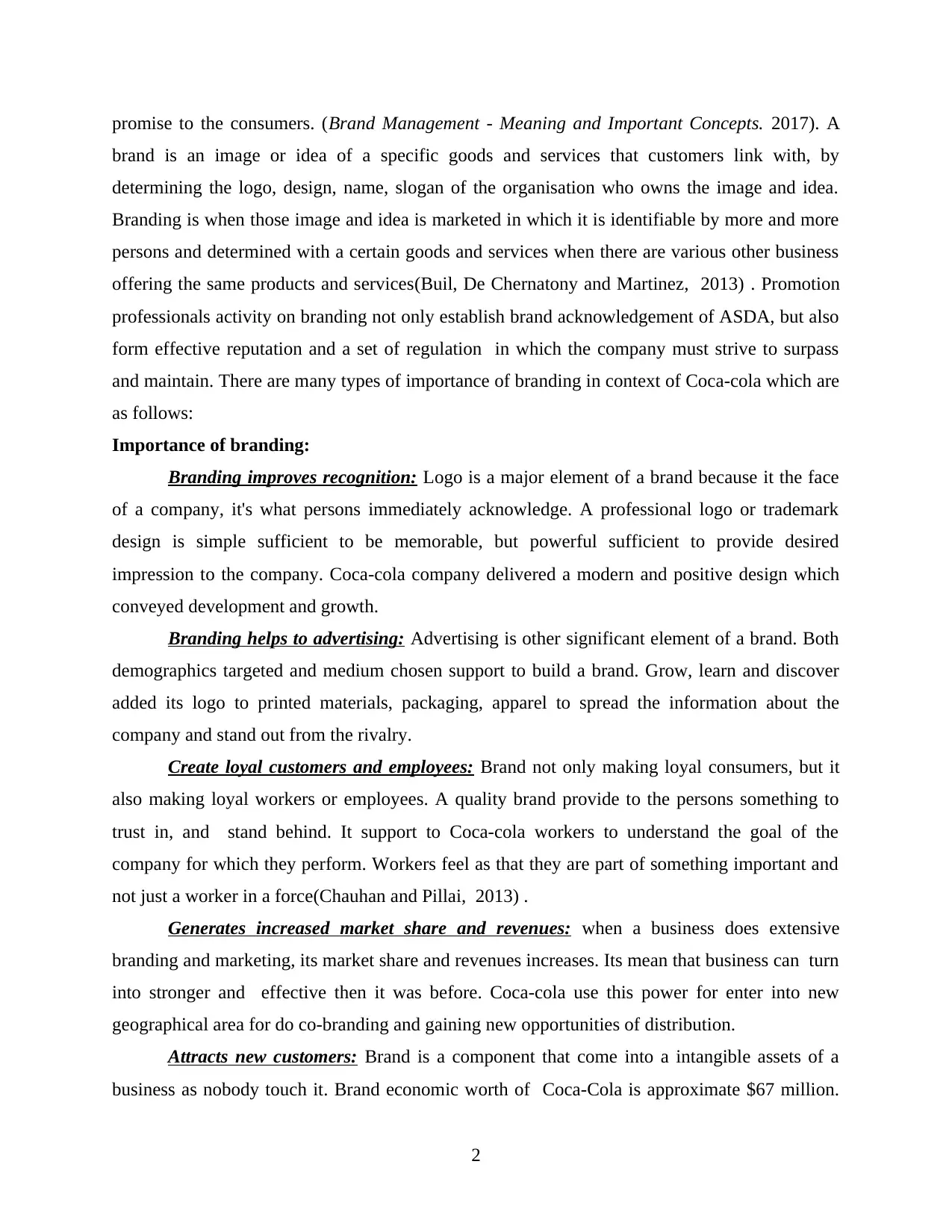
promise to the consumers. (Brand Management - Meaning and Important Concepts. 2017). A
brand is an image or idea of a specific goods and services that customers link with, by
determining the logo, design, name, slogan of the organisation who owns the image and idea.
Branding is when those image and idea is marketed in which it is identifiable by more and more
persons and determined with a certain goods and services when there are various other business
offering the same products and services(Buil, De Chernatony and Martinez, 2013) . Promotion
professionals activity on branding not only establish brand acknowledgement of ASDA, but also
form effective reputation and a set of regulation in which the company must strive to surpass
and maintain. There are many types of importance of branding in context of Coca-cola which are
as follows:
Importance of branding:
Branding improves recognition: Logo is a major element of a brand because it the face
of a company, it's what persons immediately acknowledge. A professional logo or trademark
design is simple sufficient to be memorable, but powerful sufficient to provide desired
impression to the company. Coca-cola company delivered a modern and positive design which
conveyed development and growth.
Branding helps to advertising: Advertising is other significant element of a brand. Both
demographics targeted and medium chosen support to build a brand. Grow, learn and discover
added its logo to printed materials, packaging, apparel to spread the information about the
company and stand out from the rivalry.
Create loyal customers and employees: Brand not only making loyal consumers, but it
also making loyal workers or employees. A quality brand provide to the persons something to
trust in, and stand behind. It support to Coca-cola workers to understand the goal of the
company for which they perform. Workers feel as that they are part of something important and
not just a worker in a force(Chauhan and Pillai, 2013) .
Generates increased market share and revenues: when a business does extensive
branding and marketing, its market share and revenues increases. Its mean that business can turn
into stronger and effective then it was before. Coca-cola use this power for enter into new
geographical area for do co-branding and gaining new opportunities of distribution.
Attracts new customers: Brand is a component that come into a intangible assets of a
business as nobody touch it. Brand economic worth of Coca-Cola is approximate $67 million.
2
brand is an image or idea of a specific goods and services that customers link with, by
determining the logo, design, name, slogan of the organisation who owns the image and idea.
Branding is when those image and idea is marketed in which it is identifiable by more and more
persons and determined with a certain goods and services when there are various other business
offering the same products and services(Buil, De Chernatony and Martinez, 2013) . Promotion
professionals activity on branding not only establish brand acknowledgement of ASDA, but also
form effective reputation and a set of regulation in which the company must strive to surpass
and maintain. There are many types of importance of branding in context of Coca-cola which are
as follows:
Importance of branding:
Branding improves recognition: Logo is a major element of a brand because it the face
of a company, it's what persons immediately acknowledge. A professional logo or trademark
design is simple sufficient to be memorable, but powerful sufficient to provide desired
impression to the company. Coca-cola company delivered a modern and positive design which
conveyed development and growth.
Branding helps to advertising: Advertising is other significant element of a brand. Both
demographics targeted and medium chosen support to build a brand. Grow, learn and discover
added its logo to printed materials, packaging, apparel to spread the information about the
company and stand out from the rivalry.
Create loyal customers and employees: Brand not only making loyal consumers, but it
also making loyal workers or employees. A quality brand provide to the persons something to
trust in, and stand behind. It support to Coca-cola workers to understand the goal of the
company for which they perform. Workers feel as that they are part of something important and
not just a worker in a force(Chauhan and Pillai, 2013) .
Generates increased market share and revenues: when a business does extensive
branding and marketing, its market share and revenues increases. Its mean that business can turn
into stronger and effective then it was before. Coca-cola use this power for enter into new
geographical area for do co-branding and gaining new opportunities of distribution.
Attracts new customers: Brand is a component that come into a intangible assets of a
business as nobody touch it. Brand economic worth of Coca-Cola is approximate $67 million.
2
Paraphrase This Document
Need a fresh take? Get an instant paraphrase of this document with our AI Paraphraser
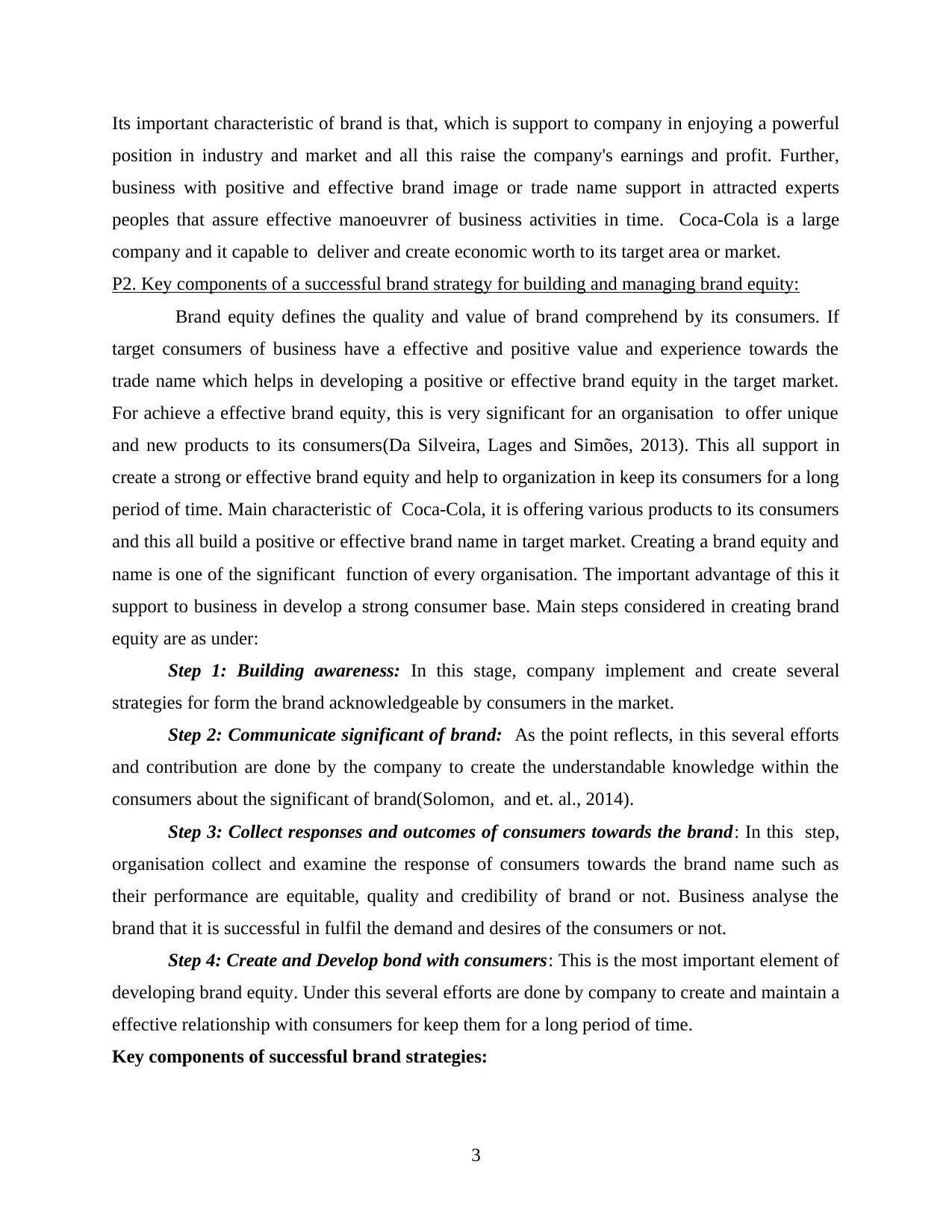
Its important characteristic of brand is that, which is support to company in enjoying a powerful
position in industry and market and all this raise the company's earnings and profit. Further,
business with positive and effective brand image or trade name support in attracted experts
peoples that assure effective manoeuvrer of business activities in time. Coca-Cola is a large
company and it capable to deliver and create economic worth to its target area or market.
P2. Key components of a successful brand strategy for building and managing brand equity:
Brand equity defines the quality and value of brand comprehend by its consumers. If
target consumers of business have a effective and positive value and experience towards the
trade name which helps in developing a positive or effective brand equity in the target market.
For achieve a effective brand equity, this is very significant for an organisation to offer unique
and new products to its consumers(Da Silveira, Lages and Simões, 2013). This all support in
create a strong or effective brand equity and help to organization in keep its consumers for a long
period of time. Main characteristic of Coca-Cola, it is offering various products to its consumers
and this all build a positive or effective brand name in target market. Creating a brand equity and
name is one of the significant function of every organisation. The important advantage of this it
support to business in develop a strong consumer base. Main steps considered in creating brand
equity are as under:
Step 1: Building awareness: In this stage, company implement and create several
strategies for form the brand acknowledgeable by consumers in the market.
Step 2: Communicate significant of brand: As the point reflects, in this several efforts
and contribution are done by the company to create the understandable knowledge within the
consumers about the significant of brand(Solomon, and et. al., 2014).
Step 3: Collect responses and outcomes of consumers towards the brand: In this step,
organisation collect and examine the response of consumers towards the brand name such as
their performance are equitable, quality and credibility of brand or not. Business analyse the
brand that it is successful in fulfil the demand and desires of the consumers or not.
Step 4: Create and Develop bond with consumers: This is the most important element of
developing brand equity. Under this several efforts are done by company to create and maintain a
effective relationship with consumers for keep them for a long period of time.
Key components of successful brand strategies:
3
position in industry and market and all this raise the company's earnings and profit. Further,
business with positive and effective brand image or trade name support in attracted experts
peoples that assure effective manoeuvrer of business activities in time. Coca-Cola is a large
company and it capable to deliver and create economic worth to its target area or market.
P2. Key components of a successful brand strategy for building and managing brand equity:
Brand equity defines the quality and value of brand comprehend by its consumers. If
target consumers of business have a effective and positive value and experience towards the
trade name which helps in developing a positive or effective brand equity in the target market.
For achieve a effective brand equity, this is very significant for an organisation to offer unique
and new products to its consumers(Da Silveira, Lages and Simões, 2013). This all support in
create a strong or effective brand equity and help to organization in keep its consumers for a long
period of time. Main characteristic of Coca-Cola, it is offering various products to its consumers
and this all build a positive or effective brand name in target market. Creating a brand equity and
name is one of the significant function of every organisation. The important advantage of this it
support to business in develop a strong consumer base. Main steps considered in creating brand
equity are as under:
Step 1: Building awareness: In this stage, company implement and create several
strategies for form the brand acknowledgeable by consumers in the market.
Step 2: Communicate significant of brand: As the point reflects, in this several efforts
and contribution are done by the company to create the understandable knowledge within the
consumers about the significant of brand(Solomon, and et. al., 2014).
Step 3: Collect responses and outcomes of consumers towards the brand: In this step,
organisation collect and examine the response of consumers towards the brand name such as
their performance are equitable, quality and credibility of brand or not. Business analyse the
brand that it is successful in fulfil the demand and desires of the consumers or not.
Step 4: Create and Develop bond with consumers: This is the most important element of
developing brand equity. Under this several efforts are done by company to create and maintain a
effective relationship with consumers for keep them for a long period of time.
Key components of successful brand strategies:
3
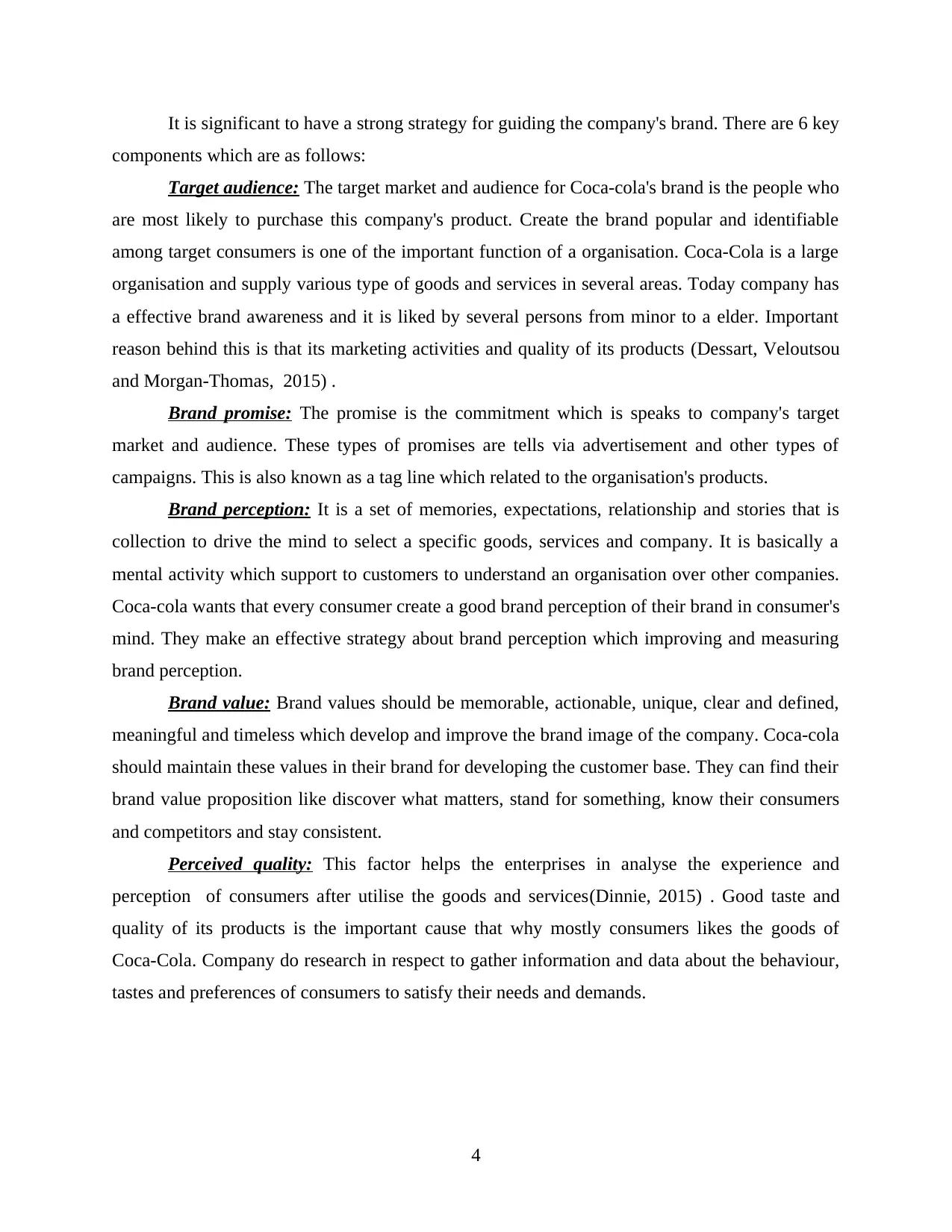
It is significant to have a strong strategy for guiding the company's brand. There are 6 key
components which are as follows:
Target audience: The target market and audience for Coca-cola's brand is the people who
are most likely to purchase this company's product. Create the brand popular and identifiable
among target consumers is one of the important function of a organisation. Coca-Cola is a large
organisation and supply various type of goods and services in several areas. Today company has
a effective brand awareness and it is liked by several persons from minor to a elder. Important
reason behind this is that its marketing activities and quality of its products (Dessart, Veloutsou
and Morgan-Thomas, 2015) .
Brand promise: The promise is the commitment which is speaks to company's target
market and audience. These types of promises are tells via advertisement and other types of
campaigns. This is also known as a tag line which related to the organisation's products.
Brand perception: It is a set of memories, expectations, relationship and stories that is
collection to drive the mind to select a specific goods, services and company. It is basically a
mental activity which support to customers to understand an organisation over other companies.
Coca-cola wants that every consumer create a good brand perception of their brand in consumer's
mind. They make an effective strategy about brand perception which improving and measuring
brand perception.
Brand value: Brand values should be memorable, actionable, unique, clear and defined,
meaningful and timeless which develop and improve the brand image of the company. Coca-cola
should maintain these values in their brand for developing the customer base. They can find their
brand value proposition like discover what matters, stand for something, know their consumers
and competitors and stay consistent.
Perceived quality: This factor helps the enterprises in analyse the experience and
perception of consumers after utilise the goods and services(Dinnie, 2015) . Good taste and
quality of its products is the important cause that why mostly consumers likes the goods of
Coca-Cola. Company do research in respect to gather information and data about the behaviour,
tastes and preferences of consumers to satisfy their needs and demands.
4
components which are as follows:
Target audience: The target market and audience for Coca-cola's brand is the people who
are most likely to purchase this company's product. Create the brand popular and identifiable
among target consumers is one of the important function of a organisation. Coca-Cola is a large
organisation and supply various type of goods and services in several areas. Today company has
a effective brand awareness and it is liked by several persons from minor to a elder. Important
reason behind this is that its marketing activities and quality of its products (Dessart, Veloutsou
and Morgan-Thomas, 2015) .
Brand promise: The promise is the commitment which is speaks to company's target
market and audience. These types of promises are tells via advertisement and other types of
campaigns. This is also known as a tag line which related to the organisation's products.
Brand perception: It is a set of memories, expectations, relationship and stories that is
collection to drive the mind to select a specific goods, services and company. It is basically a
mental activity which support to customers to understand an organisation over other companies.
Coca-cola wants that every consumer create a good brand perception of their brand in consumer's
mind. They make an effective strategy about brand perception which improving and measuring
brand perception.
Brand value: Brand values should be memorable, actionable, unique, clear and defined,
meaningful and timeless which develop and improve the brand image of the company. Coca-cola
should maintain these values in their brand for developing the customer base. They can find their
brand value proposition like discover what matters, stand for something, know their consumers
and competitors and stay consistent.
Perceived quality: This factor helps the enterprises in analyse the experience and
perception of consumers after utilise the goods and services(Dinnie, 2015) . Good taste and
quality of its products is the important cause that why mostly consumers likes the goods of
Coca-Cola. Company do research in respect to gather information and data about the behaviour,
tastes and preferences of consumers to satisfy their needs and demands.
4
⊘ This is a preview!⊘
Do you want full access?
Subscribe today to unlock all pages.

Trusted by 1+ million students worldwide
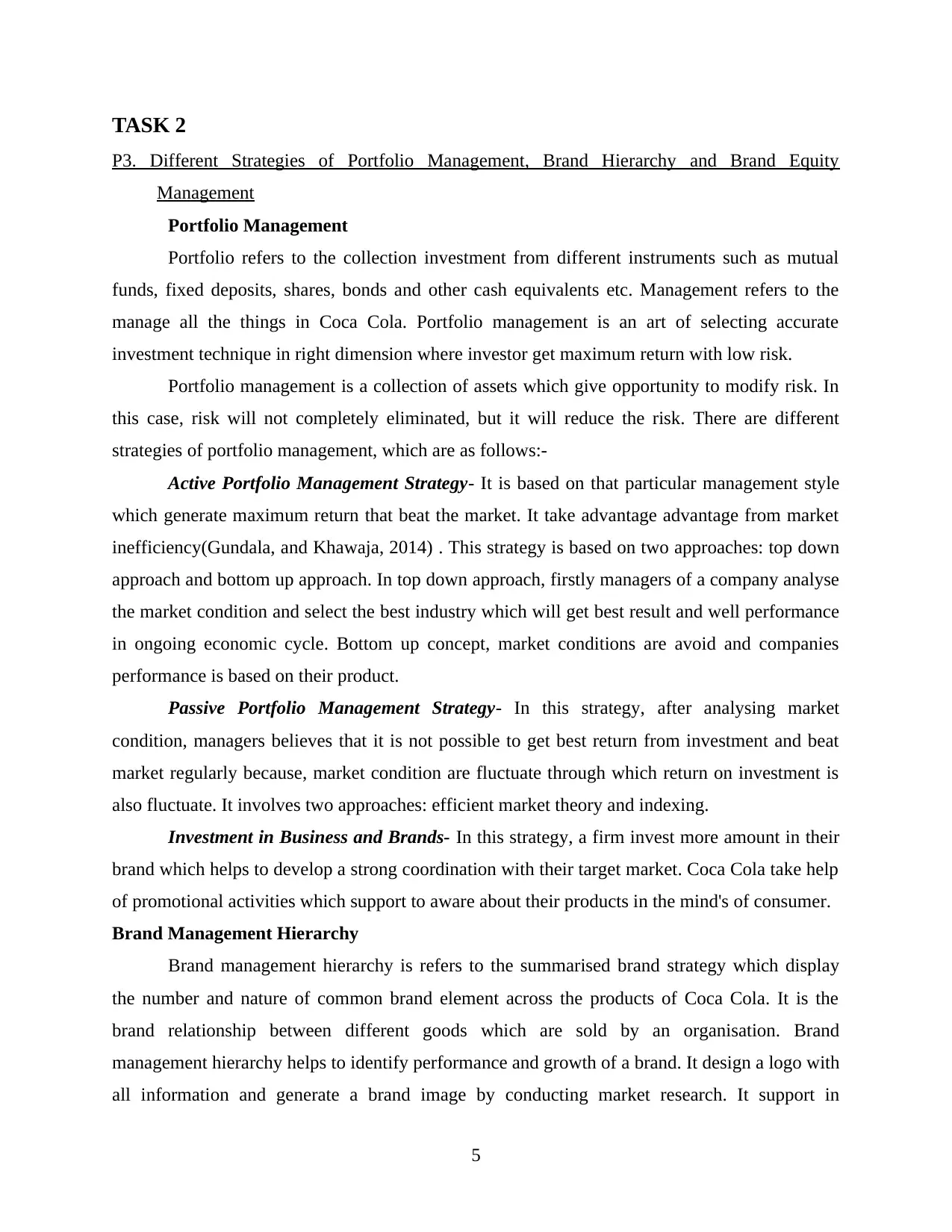
TASK 2
P3. Different Strategies of Portfolio Management, Brand Hierarchy and Brand Equity
Management
Portfolio Management
Portfolio refers to the collection investment from different instruments such as mutual
funds, fixed deposits, shares, bonds and other cash equivalents etc. Management refers to the
manage all the things in Coca Cola. Portfolio management is an art of selecting accurate
investment technique in right dimension where investor get maximum return with low risk.
Portfolio management is a collection of assets which give opportunity to modify risk. In
this case, risk will not completely eliminated, but it will reduce the risk. There are different
strategies of portfolio management, which are as follows:-
Active Portfolio Management Strategy- It is based on that particular management style
which generate maximum return that beat the market. It take advantage advantage from market
inefficiency(Gundala, and Khawaja, 2014) . This strategy is based on two approaches: top down
approach and bottom up approach. In top down approach, firstly managers of a company analyse
the market condition and select the best industry which will get best result and well performance
in ongoing economic cycle. Bottom up concept, market conditions are avoid and companies
performance is based on their product.
Passive Portfolio Management Strategy- In this strategy, after analysing market
condition, managers believes that it is not possible to get best return from investment and beat
market regularly because, market condition are fluctuate through which return on investment is
also fluctuate. It involves two approaches: efficient market theory and indexing.
Investment in Business and Brands- In this strategy, a firm invest more amount in their
brand which helps to develop a strong coordination with their target market. Coca Cola take help
of promotional activities which support to aware about their products in the mind's of consumer.
Brand Management Hierarchy
Brand management hierarchy is refers to the summarised brand strategy which display
the number and nature of common brand element across the products of Coca Cola. It is the
brand relationship between different goods which are sold by an organisation. Brand
management hierarchy helps to identify performance and growth of a brand. It design a logo with
all information and generate a brand image by conducting market research. It support in
5
P3. Different Strategies of Portfolio Management, Brand Hierarchy and Brand Equity
Management
Portfolio Management
Portfolio refers to the collection investment from different instruments such as mutual
funds, fixed deposits, shares, bonds and other cash equivalents etc. Management refers to the
manage all the things in Coca Cola. Portfolio management is an art of selecting accurate
investment technique in right dimension where investor get maximum return with low risk.
Portfolio management is a collection of assets which give opportunity to modify risk. In
this case, risk will not completely eliminated, but it will reduce the risk. There are different
strategies of portfolio management, which are as follows:-
Active Portfolio Management Strategy- It is based on that particular management style
which generate maximum return that beat the market. It take advantage advantage from market
inefficiency(Gundala, and Khawaja, 2014) . This strategy is based on two approaches: top down
approach and bottom up approach. In top down approach, firstly managers of a company analyse
the market condition and select the best industry which will get best result and well performance
in ongoing economic cycle. Bottom up concept, market conditions are avoid and companies
performance is based on their product.
Passive Portfolio Management Strategy- In this strategy, after analysing market
condition, managers believes that it is not possible to get best return from investment and beat
market regularly because, market condition are fluctuate through which return on investment is
also fluctuate. It involves two approaches: efficient market theory and indexing.
Investment in Business and Brands- In this strategy, a firm invest more amount in their
brand which helps to develop a strong coordination with their target market. Coca Cola take help
of promotional activities which support to aware about their products in the mind's of consumer.
Brand Management Hierarchy
Brand management hierarchy is refers to the summarised brand strategy which display
the number and nature of common brand element across the products of Coca Cola. It is the
brand relationship between different goods which are sold by an organisation. Brand
management hierarchy helps to identify performance and growth of a brand. It design a logo with
all information and generate a brand image by conducting market research. It support in
5
Paraphrase This Document
Need a fresh take? Get an instant paraphrase of this document with our AI Paraphraser
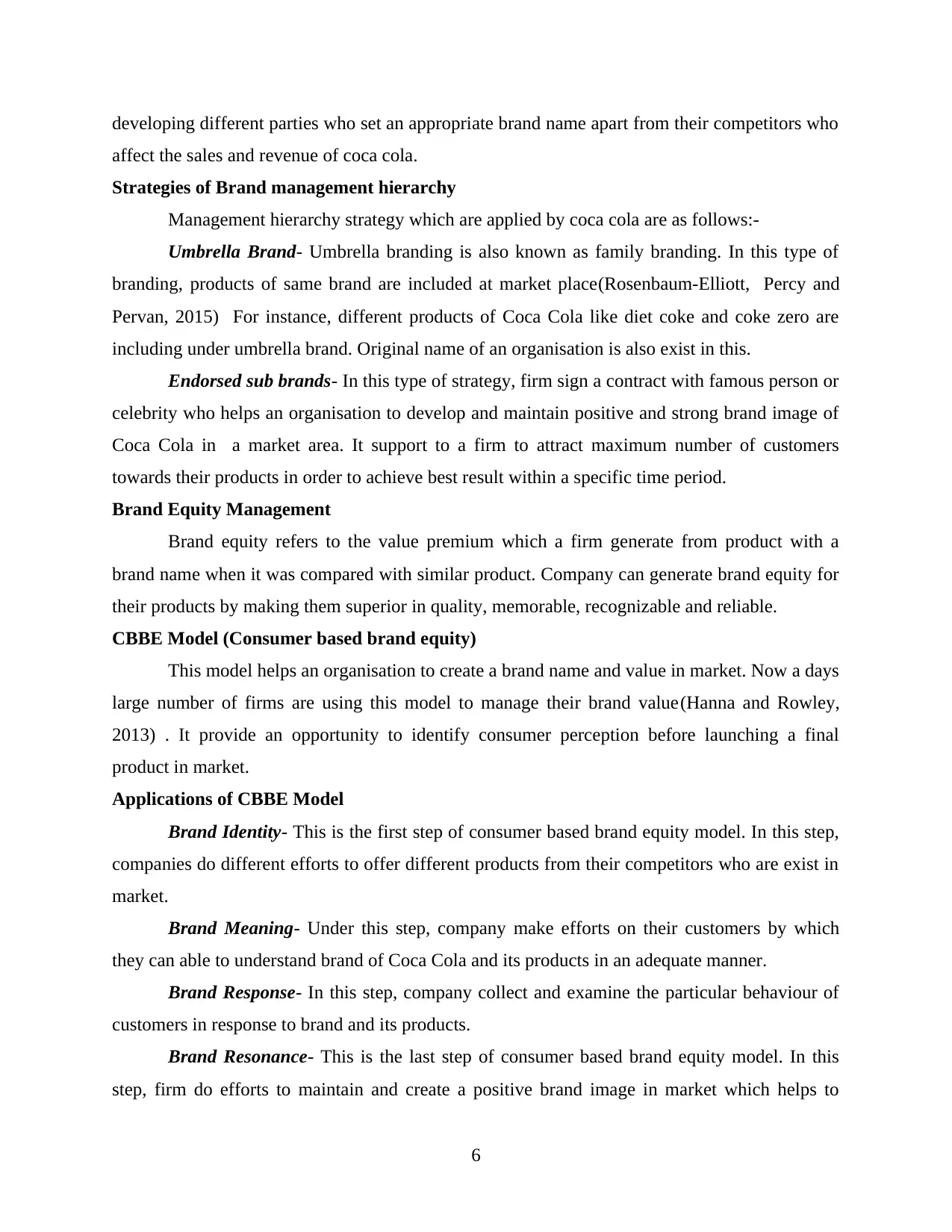
developing different parties who set an appropriate brand name apart from their competitors who
affect the sales and revenue of coca cola.
Strategies of Brand management hierarchy
Management hierarchy strategy which are applied by coca cola are as follows:-
Umbrella Brand- Umbrella branding is also known as family branding. In this type of
branding, products of same brand are included at market place(Rosenbaum-Elliott, Percy and
Pervan, 2015) For instance, different products of Coca Cola like diet coke and coke zero are
including under umbrella brand. Original name of an organisation is also exist in this.
Endorsed sub brands- In this type of strategy, firm sign a contract with famous person or
celebrity who helps an organisation to develop and maintain positive and strong brand image of
Coca Cola in a market area. It support to a firm to attract maximum number of customers
towards their products in order to achieve best result within a specific time period.
Brand Equity Management
Brand equity refers to the value premium which a firm generate from product with a
brand name when it was compared with similar product. Company can generate brand equity for
their products by making them superior in quality, memorable, recognizable and reliable.
CBBE Model (Consumer based brand equity)
This model helps an organisation to create a brand name and value in market. Now a days
large number of firms are using this model to manage their brand value(Hanna and Rowley,
2013) . It provide an opportunity to identify consumer perception before launching a final
product in market.
Applications of CBBE Model
Brand Identity- This is the first step of consumer based brand equity model. In this step,
companies do different efforts to offer different products from their competitors who are exist in
market.
Brand Meaning- Under this step, company make efforts on their customers by which
they can able to understand brand of Coca Cola and its products in an adequate manner.
Brand Response- In this step, company collect and examine the particular behaviour of
customers in response to brand and its products.
Brand Resonance- This is the last step of consumer based brand equity model. In this
step, firm do efforts to maintain and create a positive brand image in market which helps to
6
affect the sales and revenue of coca cola.
Strategies of Brand management hierarchy
Management hierarchy strategy which are applied by coca cola are as follows:-
Umbrella Brand- Umbrella branding is also known as family branding. In this type of
branding, products of same brand are included at market place(Rosenbaum-Elliott, Percy and
Pervan, 2015) For instance, different products of Coca Cola like diet coke and coke zero are
including under umbrella brand. Original name of an organisation is also exist in this.
Endorsed sub brands- In this type of strategy, firm sign a contract with famous person or
celebrity who helps an organisation to develop and maintain positive and strong brand image of
Coca Cola in a market area. It support to a firm to attract maximum number of customers
towards their products in order to achieve best result within a specific time period.
Brand Equity Management
Brand equity refers to the value premium which a firm generate from product with a
brand name when it was compared with similar product. Company can generate brand equity for
their products by making them superior in quality, memorable, recognizable and reliable.
CBBE Model (Consumer based brand equity)
This model helps an organisation to create a brand name and value in market. Now a days
large number of firms are using this model to manage their brand value(Hanna and Rowley,
2013) . It provide an opportunity to identify consumer perception before launching a final
product in market.
Applications of CBBE Model
Brand Identity- This is the first step of consumer based brand equity model. In this step,
companies do different efforts to offer different products from their competitors who are exist in
market.
Brand Meaning- Under this step, company make efforts on their customers by which
they can able to understand brand of Coca Cola and its products in an adequate manner.
Brand Response- In this step, company collect and examine the particular behaviour of
customers in response to brand and its products.
Brand Resonance- This is the last step of consumer based brand equity model. In this
step, firm do efforts to maintain and create a positive brand image in market which helps to
6
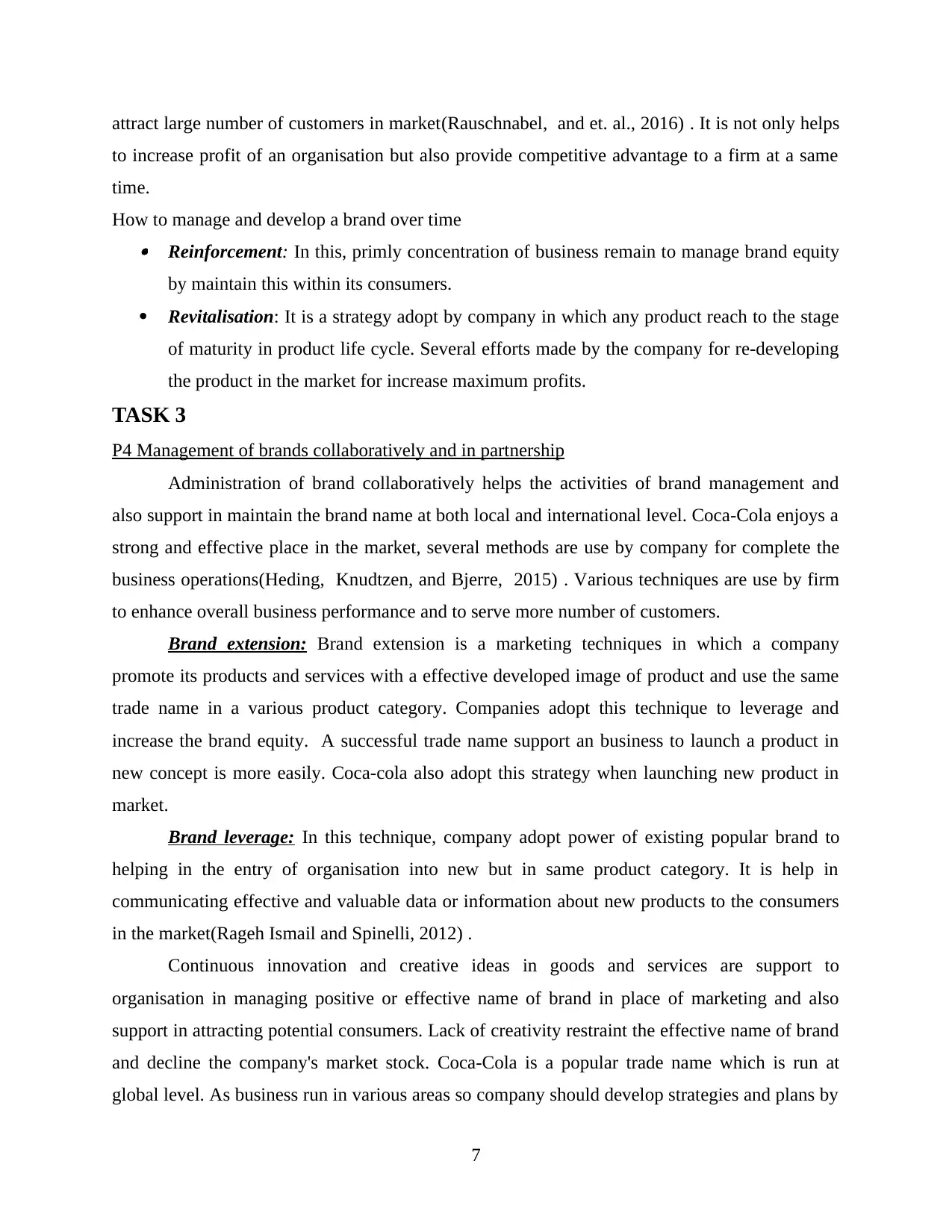
attract large number of customers in market(Rauschnabel, and et. al., 2016) . It is not only helps
to increase profit of an organisation but also provide competitive advantage to a firm at a same
time.
How to manage and develop a brand over time Reinforcement: In this, primly concentration of business remain to manage brand equity
by maintain this within its consumers.
Revitalisation: It is a strategy adopt by company in which any product reach to the stage
of maturity in product life cycle. Several efforts made by the company for re-developing
the product in the market for increase maximum profits.
TASK 3
P4 Management of brands collaboratively and in partnership
Administration of brand collaboratively helps the activities of brand management and
also support in maintain the brand name at both local and international level. Coca-Cola enjoys a
strong and effective place in the market, several methods are use by company for complete the
business operations(Heding, Knudtzen, and Bjerre, 2015) . Various techniques are use by firm
to enhance overall business performance and to serve more number of customers.
Brand extension: Brand extension is a marketing techniques in which a company
promote its products and services with a effective developed image of product and use the same
trade name in a various product category. Companies adopt this technique to leverage and
increase the brand equity. A successful trade name support an business to launch a product in
new concept is more easily. Coca-cola also adopt this strategy when launching new product in
market.
Brand leverage: In this technique, company adopt power of existing popular brand to
helping in the entry of organisation into new but in same product category. It is help in
communicating effective and valuable data or information about new products to the consumers
in the market(Rageh Ismail and Spinelli, 2012) .
Continuous innovation and creative ideas in goods and services are support to
organisation in managing positive or effective name of brand in place of marketing and also
support in attracting potential consumers. Lack of creativity restraint the effective name of brand
and decline the company's market stock. Coca-Cola is a popular trade name which is run at
global level. As business run in various areas so company should develop strategies and plans by
7
to increase profit of an organisation but also provide competitive advantage to a firm at a same
time.
How to manage and develop a brand over time Reinforcement: In this, primly concentration of business remain to manage brand equity
by maintain this within its consumers.
Revitalisation: It is a strategy adopt by company in which any product reach to the stage
of maturity in product life cycle. Several efforts made by the company for re-developing
the product in the market for increase maximum profits.
TASK 3
P4 Management of brands collaboratively and in partnership
Administration of brand collaboratively helps the activities of brand management and
also support in maintain the brand name at both local and international level. Coca-Cola enjoys a
strong and effective place in the market, several methods are use by company for complete the
business operations(Heding, Knudtzen, and Bjerre, 2015) . Various techniques are use by firm
to enhance overall business performance and to serve more number of customers.
Brand extension: Brand extension is a marketing techniques in which a company
promote its products and services with a effective developed image of product and use the same
trade name in a various product category. Companies adopt this technique to leverage and
increase the brand equity. A successful trade name support an business to launch a product in
new concept is more easily. Coca-cola also adopt this strategy when launching new product in
market.
Brand leverage: In this technique, company adopt power of existing popular brand to
helping in the entry of organisation into new but in same product category. It is help in
communicating effective and valuable data or information about new products to the consumers
in the market(Rageh Ismail and Spinelli, 2012) .
Continuous innovation and creative ideas in goods and services are support to
organisation in managing positive or effective name of brand in place of marketing and also
support in attracting potential consumers. Lack of creativity restraint the effective name of brand
and decline the company's market stock. Coca-Cola is a popular trade name which is run at
global level. As business run in various areas so company should develop strategies and plans by
7
⊘ This is a preview!⊘
Do you want full access?
Subscribe today to unlock all pages.

Trusted by 1+ million students worldwide
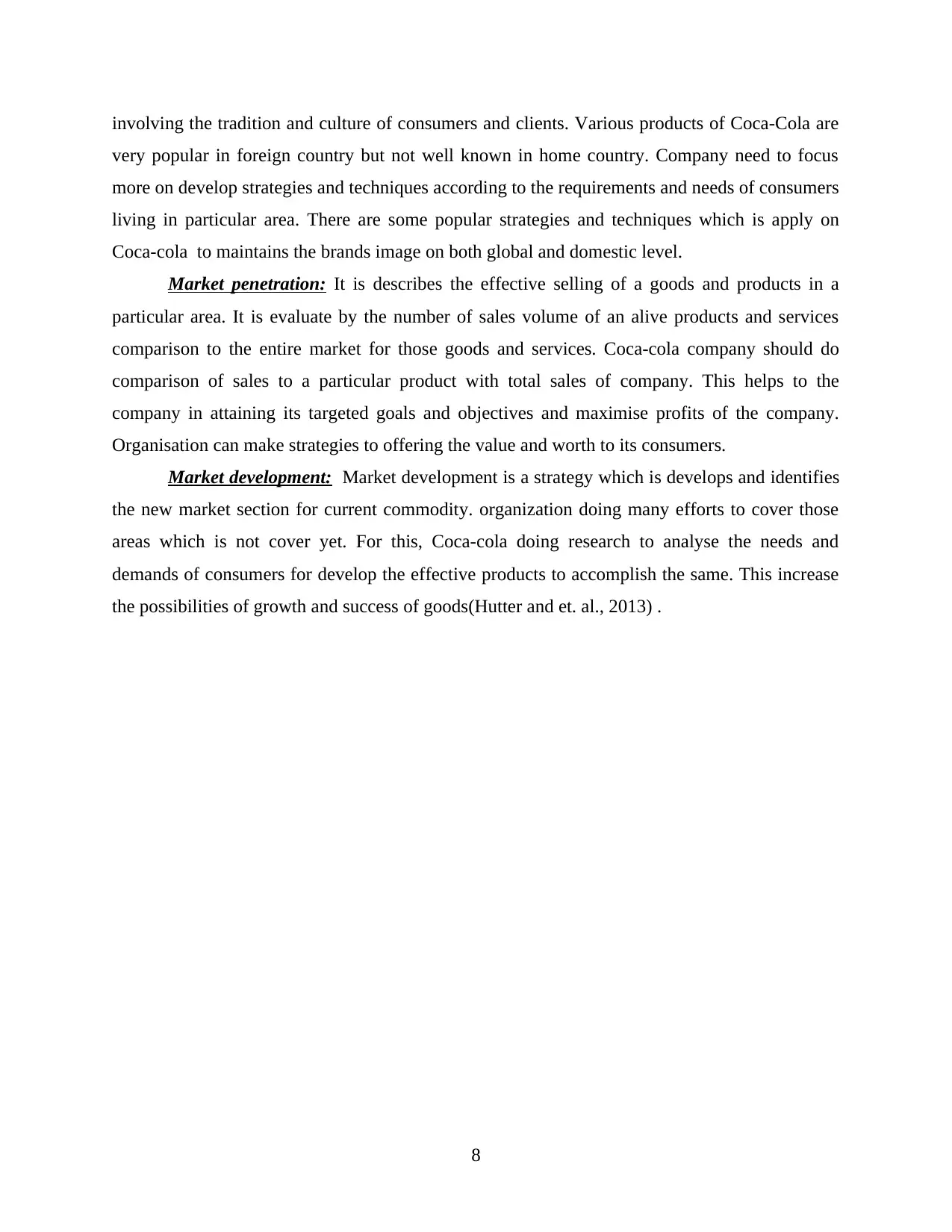
involving the tradition and culture of consumers and clients. Various products of Coca-Cola are
very popular in foreign country but not well known in home country. Company need to focus
more on develop strategies and techniques according to the requirements and needs of consumers
living in particular area. There are some popular strategies and techniques which is apply on
Coca-cola to maintains the brands image on both global and domestic level.
Market penetration: It is describes the effective selling of a goods and products in a
particular area. It is evaluate by the number of sales volume of an alive products and services
comparison to the entire market for those goods and services. Coca-cola company should do
comparison of sales to a particular product with total sales of company. This helps to the
company in attaining its targeted goals and objectives and maximise profits of the company.
Organisation can make strategies to offering the value and worth to its consumers.
Market development: Market development is a strategy which is develops and identifies
the new market section for current commodity. organization doing many efforts to cover those
areas which is not cover yet. For this, Coca-cola doing research to analyse the needs and
demands of consumers for develop the effective products to accomplish the same. This increase
the possibilities of growth and success of goods(Hutter and et. al., 2013) .
8
very popular in foreign country but not well known in home country. Company need to focus
more on develop strategies and techniques according to the requirements and needs of consumers
living in particular area. There are some popular strategies and techniques which is apply on
Coca-cola to maintains the brands image on both global and domestic level.
Market penetration: It is describes the effective selling of a goods and products in a
particular area. It is evaluate by the number of sales volume of an alive products and services
comparison to the entire market for those goods and services. Coca-cola company should do
comparison of sales to a particular product with total sales of company. This helps to the
company in attaining its targeted goals and objectives and maximise profits of the company.
Organisation can make strategies to offering the value and worth to its consumers.
Market development: Market development is a strategy which is develops and identifies
the new market section for current commodity. organization doing many efforts to cover those
areas which is not cover yet. For this, Coca-cola doing research to analyse the needs and
demands of consumers for develop the effective products to accomplish the same. This increase
the possibilities of growth and success of goods(Hutter and et. al., 2013) .
8
Paraphrase This Document
Need a fresh take? Get an instant paraphrase of this document with our AI Paraphraser
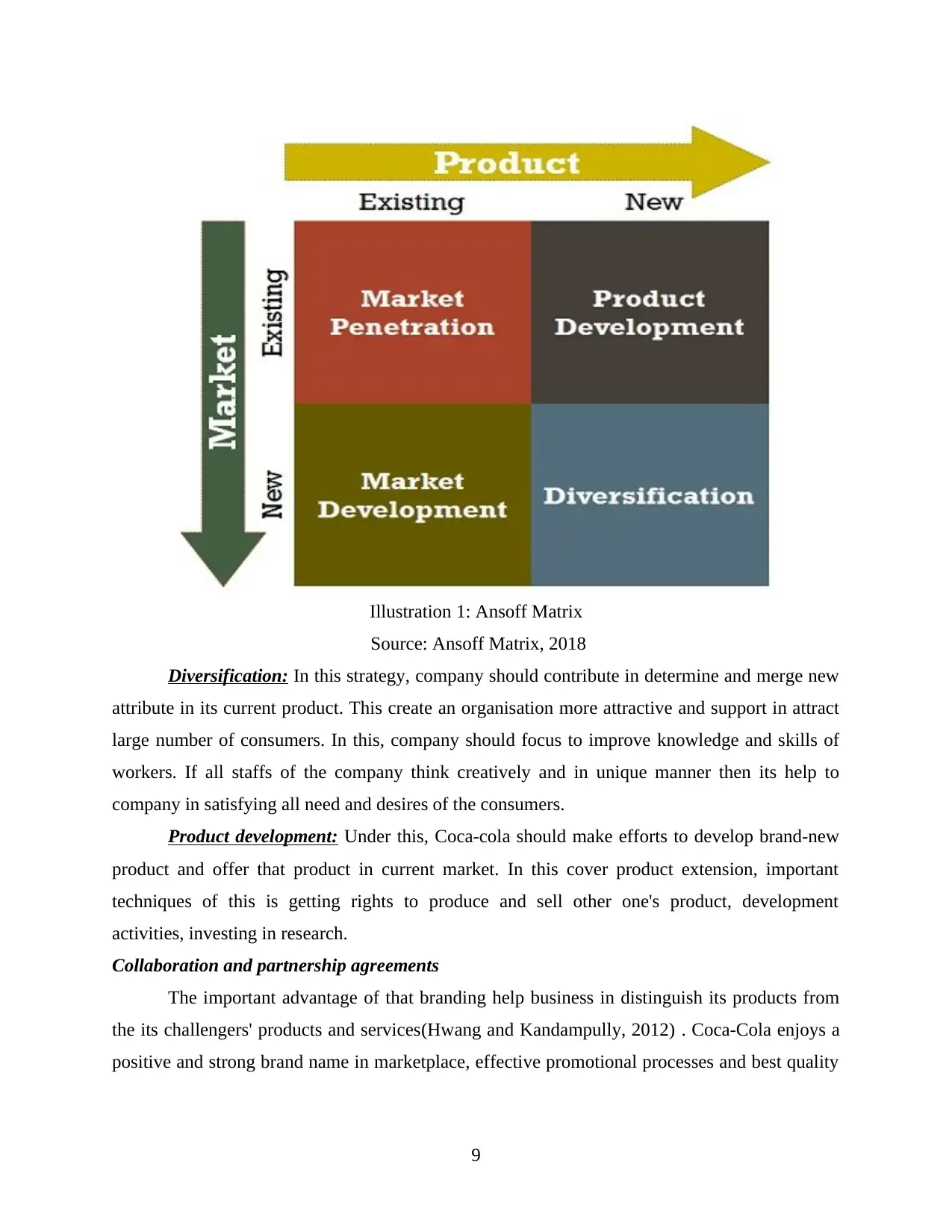
Source: Ansoff Matrix, 2018
Diversification: In this strategy, company should contribute in determine and merge new
attribute in its current product. This create an organisation more attractive and support in attract
large number of consumers. In this, company should focus to improve knowledge and skills of
workers. If all staffs of the company think creatively and in unique manner then its help to
company in satisfying all need and desires of the consumers.
Product development: Under this, Coca-cola should make efforts to develop brand-new
product and offer that product in current market. In this cover product extension, important
techniques of this is getting rights to produce and sell other one's product, development
activities, investing in research.
Collaboration and partnership agreements
The important advantage of that branding help business in distinguish its products from
the its challengers' products and services(Hwang and Kandampully, 2012) . Coca-Cola enjoys a
positive and strong brand name in marketplace, effective promotional processes and best quality
9
Illustration 1: Ansoff Matrix
Diversification: In this strategy, company should contribute in determine and merge new
attribute in its current product. This create an organisation more attractive and support in attract
large number of consumers. In this, company should focus to improve knowledge and skills of
workers. If all staffs of the company think creatively and in unique manner then its help to
company in satisfying all need and desires of the consumers.
Product development: Under this, Coca-cola should make efforts to develop brand-new
product and offer that product in current market. In this cover product extension, important
techniques of this is getting rights to produce and sell other one's product, development
activities, investing in research.
Collaboration and partnership agreements
The important advantage of that branding help business in distinguish its products from
the its challengers' products and services(Hwang and Kandampully, 2012) . Coca-Cola enjoys a
positive and strong brand name in marketplace, effective promotional processes and best quality
9
Illustration 1: Ansoff Matrix
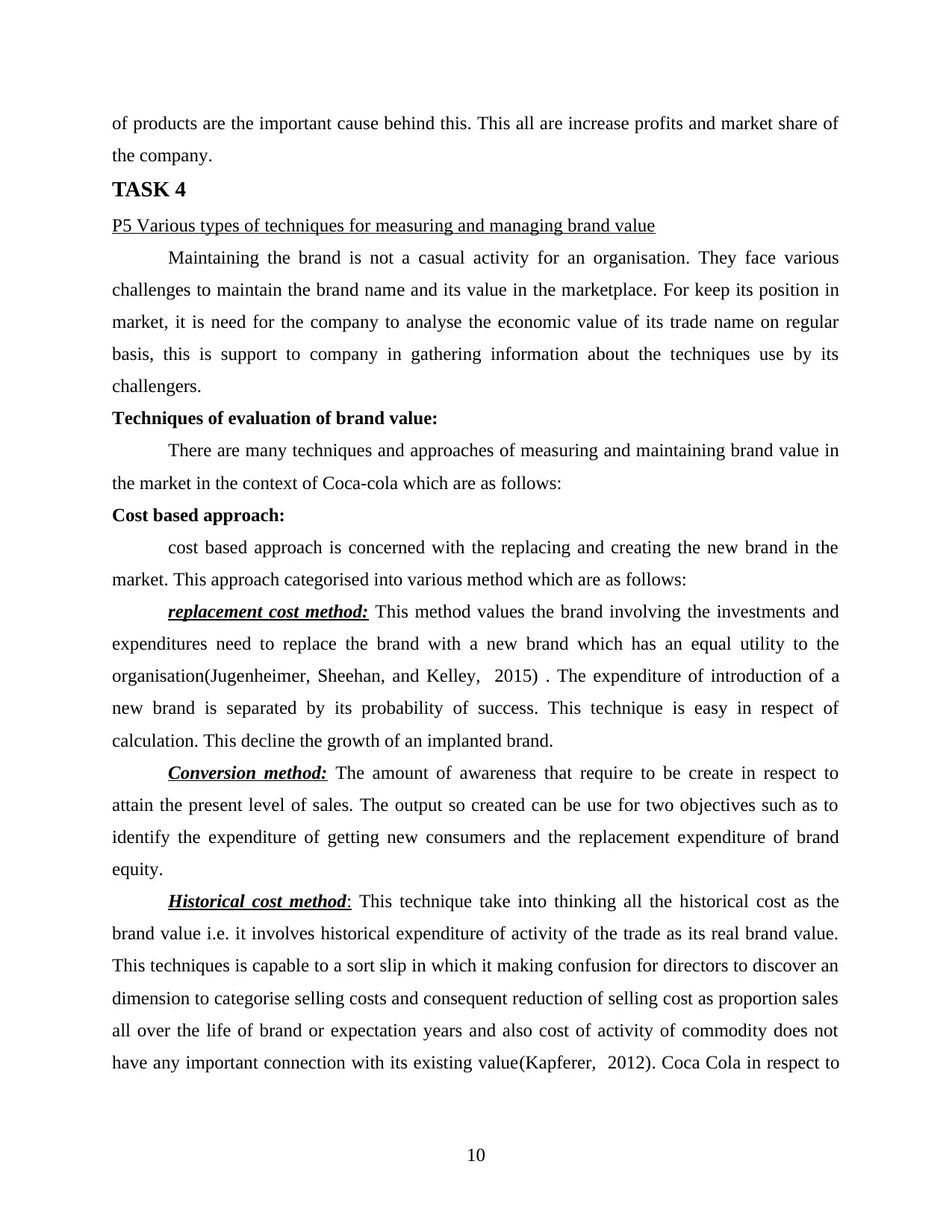
of products are the important cause behind this. This all are increase profits and market share of
the company.
TASK 4
P5 Various types of techniques for measuring and managing brand value
Maintaining the brand is not a casual activity for an organisation. They face various
challenges to maintain the brand name and its value in the marketplace. For keep its position in
market, it is need for the company to analyse the economic value of its trade name on regular
basis, this is support to company in gathering information about the techniques use by its
challengers.
Techniques of evaluation of brand value:
There are many techniques and approaches of measuring and maintaining brand value in
the market in the context of Coca-cola which are as follows:
Cost based approach:
cost based approach is concerned with the replacing and creating the new brand in the
market. This approach categorised into various method which are as follows:
replacement cost method: This method values the brand involving the investments and
expenditures need to replace the brand with a new brand which has an equal utility to the
organisation(Jugenheimer, Sheehan, and Kelley, 2015) . The expenditure of introduction of a
new brand is separated by its probability of success. This technique is easy in respect of
calculation. This decline the growth of an implanted brand.
Conversion method: The amount of awareness that require to be create in respect to
attain the present level of sales. The output so created can be use for two objectives such as to
identify the expenditure of getting new consumers and the replacement expenditure of brand
equity.
Historical cost method: This technique take into thinking all the historical cost as the
brand value i.e. it involves historical expenditure of activity of the trade as its real brand value.
This techniques is capable to a sort slip in which it making confusion for directors to discover an
dimension to categorise selling costs and consequent reduction of selling cost as proportion sales
all over the life of brand or expectation years and also cost of activity of commodity does not
have any important connection with its existing value(Kapferer, 2012). Coca Cola in respect to
10
the company.
TASK 4
P5 Various types of techniques for measuring and managing brand value
Maintaining the brand is not a casual activity for an organisation. They face various
challenges to maintain the brand name and its value in the marketplace. For keep its position in
market, it is need for the company to analyse the economic value of its trade name on regular
basis, this is support to company in gathering information about the techniques use by its
challengers.
Techniques of evaluation of brand value:
There are many techniques and approaches of measuring and maintaining brand value in
the market in the context of Coca-cola which are as follows:
Cost based approach:
cost based approach is concerned with the replacing and creating the new brand in the
market. This approach categorised into various method which are as follows:
replacement cost method: This method values the brand involving the investments and
expenditures need to replace the brand with a new brand which has an equal utility to the
organisation(Jugenheimer, Sheehan, and Kelley, 2015) . The expenditure of introduction of a
new brand is separated by its probability of success. This technique is easy in respect of
calculation. This decline the growth of an implanted brand.
Conversion method: The amount of awareness that require to be create in respect to
attain the present level of sales. The output so created can be use for two objectives such as to
identify the expenditure of getting new consumers and the replacement expenditure of brand
equity.
Historical cost method: This technique take into thinking all the historical cost as the
brand value i.e. it involves historical expenditure of activity of the trade as its real brand value.
This techniques is capable to a sort slip in which it making confusion for directors to discover an
dimension to categorise selling costs and consequent reduction of selling cost as proportion sales
all over the life of brand or expectation years and also cost of activity of commodity does not
have any important connection with its existing value(Kapferer, 2012). Coca Cola in respect to
10
⊘ This is a preview!⊘
Do you want full access?
Subscribe today to unlock all pages.

Trusted by 1+ million students worldwide
1 out of 16
Related Documents
Your All-in-One AI-Powered Toolkit for Academic Success.
+13062052269
info@desklib.com
Available 24*7 on WhatsApp / Email
![[object Object]](/_next/static/media/star-bottom.7253800d.svg)
Unlock your academic potential
Copyright © 2020–2025 A2Z Services. All Rights Reserved. Developed and managed by ZUCOL.





